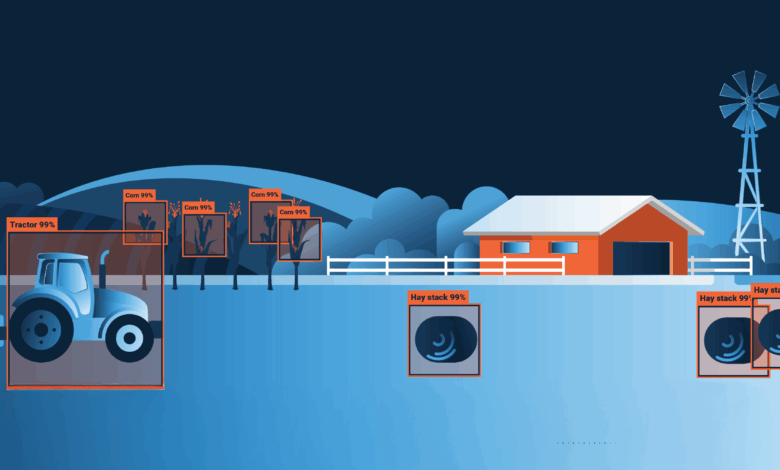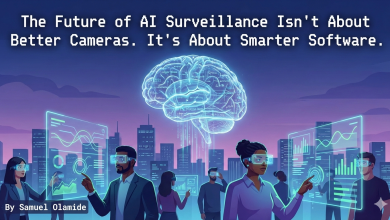
The agricultural sector is undergoing a significant transformation, driven by rapid technology advancements. According to Market.us, Artificial Intelligence (AI) in agriculture market revenue reached $1.8 billion in 2024 and is expected to expand to $2.4 billion in 2025 and $3.0 billion in 2026. Computer vision AI is at the forefront of this revolution, enabling farmers, both industrial and local, to make data-driven decisions that enhance financial and operational efficiencies, sustainability, and resilience in food production.
What is Computer Vision?
Computer vision is a branch of artificial intelligence (AI) that enables machines to “see” and interpret the world visually – similarly to the human eye, but with the precision and speed of a computer. In agriculture, this means using cameras and sensors combined with machine learning algorithms to analyze crops, soil, weather conditions, pests, and more.
Computer vision applications in farming can range from identifying diseases in plants before they spread, to monitoring livestock health, to optimizing irrigation by detecting moisture levels in soil. It’s not just high-tech theory; it’s already being used in tractors, drones, and smartphone apps.
Precision Agriculture: Enhancing Crop Monitoring
Through computer vision AI, farmers can detect early signs of crop stress, disease, or pest infestation. For example, a drone with a multispectral camera can fly over fields and generate images that reveal subtle changes in plant color, indicating possible health issues before they become visible to the naked eye. By catching problems early, farmers can treat affected areas instead of entire fields, reducing costs and saving crops.
Yield Forecasting and Planning: Reducing Waste
AI models can accurately predict crop yields by continuously analyzing visual data across growing seasons. These insights allow farmers to better plan labor, logistics, and sales strategies, maximizing returns. Platforms like Taranis and Sentera are helping farmers globally enhance their harvest predictions using AI and computer vision.
Weed and Pest Control: Streamlining Operations
Autonomous machinery equipped with computer vision can identify and target weeds individually, reducing the need for blanket herbicide application. This lowers chemical costs, prevents resistance buildup in pests, and preserves soil health. Systems like Blue River Technology’s See & Spray have shown significant savings for large-scale farms.
Labor Efficiency: Addressing Labor Shortages
Labor shortages are a persistent challenge in agriculture. Computer vision allows machines to perform tasks such as fruit picking, plant counting, or livestock monitoring. These technologies reduce dependency on manual labor and ensure timely harvesting, which is especially critical in perishable crop production.
Environmental Impact: Promoting Sustainable Practices
While promoting healthier soil and more efficient inputs contribute to regenerative agriculture practices, which is great for the environment, computer vision also contributes significantly to sustainable practices.
It helps conserve water through image-based moisture mapping, a process that allows farmers to implement precision irrigation, watering only where and when needed. This helps conserve freshwater resources, reduce energy usage, and minimize runoff that could pollute nearby ecosystems.
Computer vision minimizes the overuse of fertilizers and pesticides by applying them only in areas that need treatment. This leads to less chemical runoff, essential for protecting biodiversity and maintaining long-term soil fertility.
Through the automation of the crop monitoring process, computer vision also reduces the number of field trips, which helps lower fuel consumption and greenhouse gas emissions.
Supply Chain and Market Optimization
Computer vision doesn’t stop at the field; it’s also used post-harvest to grade produce, detect defects, and automate sorting. High-quality produce fetches better prices, and consistent grading helps maintain market reputation.
Furthermore, image data helps optimize cold storage and transportation, reducing spoilage. With tools like AgShift, farmers and cooperatives can increase transparency and trust in the supply chain.
Barriers to Adoption
While promising, these technologies come with challenges. High upfront costs can be a barrier, especially for small farmers. However, many companies now offer subscription models or cooperatives that share equipment and costs.
Integration with existing farm operations also requires training and possibly new infrastructure. And while smartphone-based tools make access easier, reliable internet connectivity remains an issue in many rural areas.
Government incentives, public-private partnerships, and local tech incubators are increasingly stepping in to bridge this gap. Platforms like USAID’s Feed the Future promote precision agriculture in developing regions.
Conclusion
Computer vision is more than just a buzzword; it’s a practical tool that can help farmers increase profits, improve crop quality, and operate sustainably. By leveraging these technologies, farmers gain better control over their operations, reduce waste, and meet the demands of a growing global population.
Adopting computer vision isn’t about replacing traditional farming methods but enhancing them with new capabilities. Whether you’re managing a few acres or thousands, this is a tool worth considering to make farms smarter, more efficient, and ultimately, more profitable.




